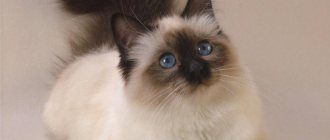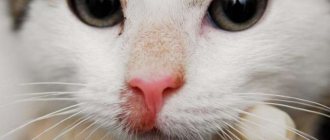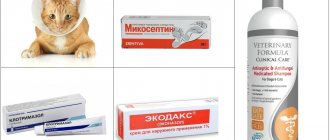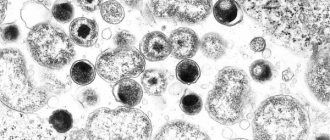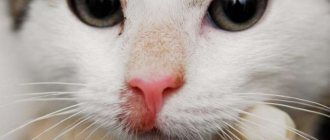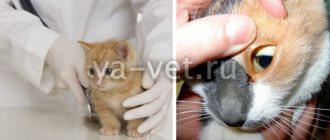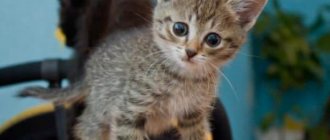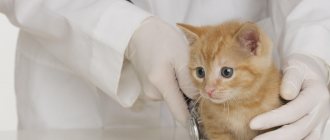Ringworm (microsporia) is a disease manifested as a fungal infection of the skin, nail plates and hair follicles. The pathogen is a mold fungus of the genus Microsporum. Its colonies form in keratinized substrates. Microsporia remains a relatively common disease - dermatologists identify 60-75 cases for every hundred thousand Moscow residents. The pathology has a pronounced seasonality. The peak incidence occurs at the end of summer and beginning of autumn - the period of breeding of offspring in cats and other animals.
What is ringworm in cats and what does it look like?
This disease is the collective name for fungal infections that mainly affect the pet’s skin and, less commonly, the claws. Moreover, it does not matter whether the animal goes outside or is completely domestic. The disease is transmitted by trichophyte and dermatophyte fungi, which is why lichen is also called microsporia, trichophytosis or dermatophytosis.
Lichen spores can only be examined under a microscope; they can be transmitted through the air and settle on clothing and any surfaces. Therefore, close contact with the carrier of the disease is not necessary - an animal can get sick if it rubs against its owner’s clothes or lies on the grass where a sick cat was previously sitting.
Tiny spores can remain for a long time in the grass and on the ground, furniture, carpet or clothing. They retain good viability for almost 2 years, and when exposed to favorable conditions (warmth and high humidity), they begin to actively reproduce and cause disease.
In order to detect the disease in time at the initial stage, you need to know what the sick animal looks like. The main symptom of lichen is breaking off and loss of hair on the affected areas of the skin. Bald and flaky pink spots on the skin resemble those cut with a clipper, which is how the disease got its name.
The following animals are most often susceptible to deprivation:
- small kittens;
- young individuals up to 1 year of age;
- adults whose immunity is weakened due to an inadequate diet and lack of nutrients;
- long-haired breeds;
- cats with malignant processes in the body.
Signs and symptoms
The incubation period of the disease is almost 3 months, so symptoms may not appear immediately. At the initial stage, it is almost impossible to recognize the first signs and determine lichen in a cat, but already at this stage the pet becomes infectious to the people and animals around it.
The main symptoms of ringworm in cats:
- deterioration in the condition of the coat is expressed in its breaking off, dullness and greasy;
- in some places bald spots appear, on which broken hairs are visible, gradually this area becomes more bare;
- bald areas become pink (less often gray-brown) and begin to become covered with scales and crusts;
- the animal loses its appetite, becomes lethargic and apathetic;
- due to constant itching, the cat begins to actively itch and bleeding scratches appear;
- when the claws are damaged, they become deformed;
- Over time, blisters may appear on the surface of the epidermis, which become covered with crusts, and if a secondary infection occurs, ulcers may appear.
The degree of damage to the skin and fur manifests itself depending on the state of health and immunity of the animal: in a healthy cat, only 1-2 spots are possible, in a weakened cat, lichen covers large areas of the body. The most commonly affected areas are the head, neck, muzzle, ears, back, tail and paws in the claw area.
Where does it most often appear?
Usually the disease is localized on the head, ears, muzzle of the animal, on its limbs or tail.
By scratching the infected areas, the cat spreads the infection throughout the body - if treatment is not started in time, the disease will spread over most of the animal's skin.
Perhaps the cat does not have lichen, but baldness.
Diagnosis of the disease
If you have any skin diseases or suspicion of ringworm in your pet cat, you should immediately take your pet to a veterinarian. Only a specialist can diagnose the pathology and prescribe the correct treatment.
What does ringworm look like in cats?
Above the eye Behind the ear Photo - what lichen looks like on a cat’s back
In a veterinary clinic, the diagnosis is confirmed using fluorescent (under a lamp), microscopic and cultural (bacterial culture) studies.
Treatment for ringworm at home
A consultation with a veterinarian will help you find out how and how to treat ringworm in cats. After confirming the diagnosis in the laboratory and prescribing drug therapy by the doctor, the owner of the sick animal is recommended to take the following actions:
- try to isolate the sick pet from people and pets or minimize their contacts, prevent their presence on beds, sofas, etc.;
- be sure to examine all pets for signs of deprivation and take preventive measures;
- Until recovery, the cat cannot be bathed, because this will cause the spread of fungal spores throughout the body, with the exception of special medicated shampoos;
- treat the animal with gloves and do not stop treatment until complete recovery;
- improve the diet and living conditions of a sick pet to improve immunity.
Folk remedies also have a positive effect:
- An ointment based on wood ash and pork fat or butter (mixed in equal proportions). Used to treat the source of infection. A bandage is placed on top, which helps enhance the effect and prevent the cat from licking the medicine.
- Bathing in a solution of lime sulphide (1 tsp per 5-6 liters of warm water). The cat must be completely immersed in a container with the solution, and the diseased areas must then be moistened additionally. After the procedure, the fur should be blotted with a cotton towel or paper napkins and dried; do not allow the pet to lick itself. The method is not suitable for kittens, because... Possible side effects such as allergies, skin irritation or vomiting.
- Treatment of diseased areas with a solution of laundry soap (you will need 10-15 g of shavings per 1 liter of water). Wet a cotton pad and use it to remove dried crusts.
- Lubricating foci of infection with iodine or propolis 1-2 times a day. This method is contraindicated for pets with particularly delicate skin, because... burns may occur.
It is recommended to give a pregnant cat a decoction made from medicinal herbs (chain, nettle, violet, 0.5 tsp per 0.5 liter of boiling water). It is infused for 20 minutes, filtered and given to the animal 3-4 times a day.
The disadvantage of traditional methods of treatment at home is their low effectiveness, as a result of which the disease can become chronic. Therefore, for a faster positive result and complete cure, experts recommend using medications.
Types of cat lichen with photos
Ringworm is a dermatological disease caused by various fungi or viruses. In cats, it appears on the skin, fur or claws, and its species have different variants of appearance.
When fungal spores enter the body of domestic animals, the latent period (incubation) lasts from several days to a month, then the external manifestations of cat lichen begin, which is distinguished primarily by hair loss on the skin. Among the cat species there are the following:
Lichen planus
Appears when the animal’s immune system fails. The reasons for its occurrence are unknown, and it is not transmitted to other individuals. Characterized by itchy red blisters with liquid on the skin or mucous membranes. When scratched, the pimples burst, causing more itching.
Pityriasis rosea
Transmitted virally from one animal to another. This type of lichen occurs in kittens and adults, but goes away on its own when the immune system is strengthened. It looks like a pink spot measuring 1.5 to 2 cm, the surface of which is flaky and itchy.
Ringworm (eczema)
Sometimes accompanied by fungal infections. It looks like inflamed reddish spots with blisters, as well as severe itching. When scratching pimples, the itching becomes even stronger. Not contagious to other animals.
Pityriasis versicolor (variegated)
Occurs from a fungal infection. Popular in countries with hot climates, it spreads quickly and unnoticed. It looks like small yellow-brown spots, without much inflammation.
Ringworm
The most common and dangerous lichen in cats. We will talk about it further.
Treatment with drugs
Treatment of lichen is carried out comprehensively and systematically using the following anti-lichen drugs prescribed by a veterinarian:
- Vaccines for the treatment of ringworm (trichopytosis and microsporia) - Vakderm F, Polivac TM, which are administered intramuscularly in the area of the femoral muscle 1-2 times with an interval of 2 weeks. Used at the initial stage of the disease.
- Ointments with antimycotic action. Used for local treatment.
- Special shampoos with antifungal ingredients (Nizoral with ketoconazole, Doctor skin shampoo, Antiseptic & Antifungal vet shampoo). They are an addition to the main course of treatment, because help reduce itching, have a positive effect on the skin and speed up recovery. Before use, the area around the affected area must be shaved and treated with an antiseptic.
- Sprays for animals (Fungin, Vakderm, Mycostop Provet). Medicines containing clotrimazole, which are applied to the affected area, the course is 1-2 weeks.
When choosing medications for complex therapy, the veterinarian takes into account several factors:
- the size and number of affected areas on the pet’s skin;
- severity of the disease and general condition of the animal;
- state of immunity.
You should know that antifungal drugs should be used in quantities of no more than 2 types and forms, so that the active ingredients do not accumulate in the animal’s body, because this can lead to toxic poisoning.
Tablets for lichen
Antifungal medications taken orally, in tablet form:
- Griseofulvin (analogs Gricin, Fulcin, etc.). Intended for the treatment of humans, but can also be used for cats. The dosage depends on the weight of the pet - 40 mg/kg, given half or a whole tablet crushed into powder twice a day with food. The medicine has side effects (diarrhea, nausea, liver damage, lethargy) and contraindications.
- Itraconazole (or similar drugs Irunin, Orungal, etc.). Available in tablets and capsules, for cats the dosage is ¼ tablet twice a day (for kittens - 1/8 tablet or capsule, depending on the pet’s weight 10 mg/kg). Give with food for 7 days, then another 2 weeks - every other day in the same amount. The course of treatment is from 4 to 6 weeks. Possible side effects such as nausea and decreased appetite.
- Terbinafine (analogs Lamisil, Exifin). It is given to animals at the rate of 30 mg per kilogram of weight for 3-4 weeks, and is also used in kittens. Side effects include loss of appetite and allergic reactions due to individual intolerance.
In addition, there are drugs in the form of injections. One of them is Dermikotsid, which is an antifungal drug for the treatment of microsporia and trichophytosis. Injections are given into the thigh muscles 2-3 times with an interval of 5 days. For kittens, the dosage is 0.5 ml, for adult pets - 1-1.5 ml. The drug has side effects in the form of an individual reaction on the skin (urticaria, rash), the appearance of redness in the eyes and mucous membranes of the mouth.
Ointments
Before starting local skin treatment with gels or ointments, it is necessary to trim the hair around the diseased area and remove crusts, which will help improve contact of the medicine with the epidermis. To prevent the cat from licking the applied ointment, it is necessary to put a special collar or bandage on it.
To improve the condition of the epidermis and local antifungal action, the doctor prescribes an ointment for ringworm from the following list:
- Clotrimazole. The gel is applied to the affected areas three times a day for up to 30 days (if necessary, longer, until complete recovery).
- Sanoderm. A complex drug that includes a local antibiotic, an antimycotic drug and anti-inflammatory ingredients. Apply 1-2 times a day for 2-4 weeks (duration depends on the severity of the disease). Before using it, you should consult a veterinarian, i.e. the drug has contraindications.
- Miconazole. A remedy for the treatment of fungal diseases in people and animals, which need to be smeared twice a day on diseased areas, the course is 1-2 months.
- Fungin. An effective remedy in the treatment of trichophytosis and microsporia. Apply in a dosage of 0.2-0.3 ml per 1 kg of pet’s weight using a cotton pad and gently rubbing into the skin. Treatment should be carried out daily for 12-15 days.
- Sulfuric ointment. It is a simple, cheap and most harmless way to cure skin diseases, but is effective only for minor lesions. Apply 3-4 times a day to diseased areas of the skin.
- Ointment "Yam". It has acaricidal, fugicidal and keratolytic effects, applied in a thin layer to the skin and around the affected area (3-4 cm more) 1-2 times a day, the course of treatment is 8-10 days.
In chronic forms of lichen and severe bleeding scratches, a secondary microbial infection may occur and symptoms of purulent dermatitis may appear. In such a situation, the doctor prescribes antibiotics in the form of injections or tablets.
Treatment for ringworm takes at least 1-1.5 months. Evidence of a cat’s recovery is not the disappearance of external signs of the disease, but a negative result after testing scrapings taken from the animal’s skin (sometimes the testing procedure is carried out twice).
Is ringworm transmitted to humans?
The main danger of the disease is that lichen is contagious to humans. In this case, people can be affected in any part of the body (arms, legs, etc.), often the skin under the hair on the head. Pink spots appear with clear edges. They may be slightly raised above the skin. Hair on the spots always falls out and grows back only after the end of the course of therapy and cure.
Most often, children of preschool age, who have not yet developed immunity, and adults who have a weak immune system are infected with lichen. In people with a strong, healthy body and high immunity, fungal spores can live on the skin for quite a long time and remain in a suppressed state.
Methods of infection
To date, there is no consensus on the methods of infection.
There is an assumption that the source of the disease is the herpes virus and that people with low immunity, those who have recently suffered viral infections, colds, and who are often hypothermic are primarily at risk of contracting Zhiber's disease. Women and children have a significantly higher risk of infection than men. Observations show that people over 40 years of age and infants practically do not become infected with this infection. Is this disease contagious? There is no clear answer to this question. There is an opinion that it can be transmitted through tactile contact or airborne droplets. A prerequisite for a person to become infected is the presence of a provoking factor. In practice, it has been noted that transmission of this virus from one person to another occurs infrequently.
Can other animals become infected?
This easily transmitted disease is spread by fungal spores that can affect any mammals, which include dogs, cats, and rodents. Animals that live outdoors are at greatest risk.
When one infected pet appears, everyone around them is at risk of getting sick. The infection may quickly spread among residents of shelters or cat and dog kennels. Therefore, it is so important for the owner to isolate the sick animal from people and other pets.
Routes of transmission of ringworm
Spores of the fungus that causes the disease can spread quickly through the air, in the aquatic environment and through clothing.
Main routes of transmission:
- in direct contact with a sick animal (if protective equipment is not used);
- with indirect contact, infection can occur through pet care items - a bed, food bowls, harness or leash;
- through other carriers of infection - rodents (mice and rats);
- in the environment, spores can spread with water or through the air, through soil, sand, garbage, upon contact with which the fungus begins to develop;
- through items of clothing or shoes of the owner or other people coming into the house.
Information about the disease
Ringworm in cats is an infectious disease caused by two types of microscopic fungi: Mycrosporum and Trichophyton.
In the first case, the type of lichen is called microsporia, and in the second - trichophytosis. The clinical symptoms of both pathologies are identical.
Microsporia and trichophytosis fungi quickly reproduce by spores, therefore they are very widespread in the environment. These fungal spores can be found anywhere other cats infected with the disease have been.
A decrease in the animal's immunity can cause this disease. To strengthen the animal’s body’s defenses, it is necessary to get vaccinated and know what to feed the cat.
Fungal spores can remain viable in the external environment for up to two years. They are highly resistant to adverse conditions and many disinfectants.
The risk of contracting ringworm for a cat is very high. However, the body of adult and healthy felines has the ability to successfully resist this disease.
Who is at risk
- Kittens up to 1 year.
- Sick animals.
- Cats with weakened immune systems in the postoperative period or after illnesses.
- Free-ranging animals.
You might be interested in:
- scabies in cats.
Prevention of lichen in cats
The main measures to prevent infection of pets with lichen include:
- good care and maintenance of the pet’s health and immunity;
- maintaining cleanliness in the room where animals live: regularly sanitize the bedding, house, feeder and drinking bowl, care accessories;
- when walking on the street, avoid contact with homeless and stray cats and dogs;
- carrying out preventive vaccinations that help protect the animal from ringworm and other types of lichen (these include Polivak TM, Vakderm, Microderm, etc.); with regular use of vaccines, the animal develops immunity to skin diseases;
- if your pet is suspected of being infected with lichen, it is necessary to provide personal means of protection against infection - wear a gown and rubber gloves when carrying out medical and other procedures for caring for a sick animal;
- After isolating a sick cat in a separate room, it is recommended to subject it to quartz treatment daily using a special lamp, and to carry out wet cleaning with a chlorinated solution (chlorhexidine or alcohol can be used).
The measures listed will help protect animals from infection, even in a situation where there is an animal with shingles in the house. If you follow all the doctor’s recommendations and the proper quality of treatment and maintain the health of your pet, lichen can be cured and complications and the transition of the disease to the chronic stage can be avoided.
How to avoid infection
Due to the fact that the nature of the occurrence of Gibert's disease has not been thoroughly studied, there are no methods to prevent this disease. The main recommendation is to monitor the state of the immune system, as it will help avoid infection.
Complications
The disease itself in most cases goes away without leaving a trace. However, sometimes complications arise in the form of eczema, staphylococcus or streptococcus; ring-shaped lichen can develop, which quite often becomes chronic and even after a few years a relapse can occur. Then treatment is done with antibiotics. To prevent such problems, we strongly recommend that you undergo comprehensive treatment in our clinic. Don't forget about your health and the health of your family!
